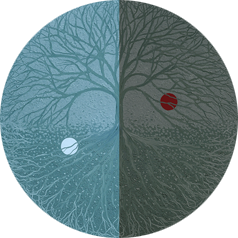
Foreword By Ms Sushma K. Bahl
There the eye goes not,
speech goes not, nor the mind.
We know not, we understand not,
how one would teach it?– Kena Upanishad 1.3a, Translated by Woodburn
Artist Kota Neelima delves deep in this perennial search through a series of 28, oil on canvas paintings ‘What the Eyes Can See’ as it attempts to see what lies beyond the obvious. Inspired by her readings of Vedic treatise Kena Upanishad (Keno a Sanskrit word literally means what whom whence how why or from what cause), a dissolution of the seen image, informed by the lived experience and intuitive knowing, appears to be at the heart of what is re-presented and re-created in her art as memory, perception and forecast.
Causation and its deconstruction has been a recurring theme in Neelima’s work over the years. In ‘Neutral Witnesses’ (2009) series of paintings she addressed agents of causation and in ‘First Cause’ (2012) her work focused on karma. In the present ‘What the Eyes Can See’ series, her art takes a further leap as it turns to the medium of causation through sensory structures and its vulnerability to simplified explanation. The experimentation begins with an intense journey that Neelima undertakes via her paintings to distinguish between looking and seeing or the internal self and the external world and its effect, tangled at every level of existence and awareness. This leads to the demarcation of the seen from the unseen and the one seeing as distinct from the other looking or looking through.
Questions about what makes the eyes see, what makes the mind think, how the transcendental forces facilitate the sensory or spiritual experience reverberate through her semi abstract impressionistic opaque imagery. The dichotomy between sight and vision, seeing and imagining, experiencing and analyzing, sensory and spiritual as well as manifest and no manifest, that engage the artist also draw her viewers in, to look beyond what the bare eye can see. With its focus on prana (life force) – speech, sight, hearing and other senses, the work incorporates ideation around the finite and the infinite, the external and the internal, the ephermal and the perennial.
The paintings translate into colour and form, as a multiplicity of visuals that the eyes can see while they also reflect what lies beyond the visual and in one’s mindscape. Working with semiabstract technique, the artist begins with pencil and charcoal sketches on paper, which are then worked upon to finish as oil on canvas paintings. Vibrant trees that flower in brilliant colours of life, roots that seek the depths, the sun, the moon, the sky and the waters that sustain the universe and birds that find the heights, all figure in her work as she discovers the conventional and the unconventional, the bound and the unbound. Though it defies tangibility, her art evokes multi-layered possibilities of – past present and future.
Kota Neelima, a multitalented and accomplished person-author, journalist, scholar and painter – wears many hats with equal élan. I wish her success in her varied endeavors including the admirable work in this series that unravels the mystery of ‘ways of seeing’
Ms Sushma K Bahl is an independent arts adviser, writer and curator of cultural projects.
